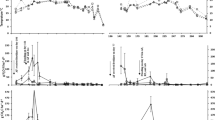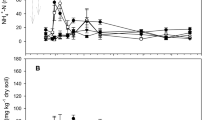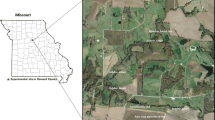Abstract
The potential for agricultural soils to act as a sink and sequester carbon (C) or a source and emit carbon dioxide (CO2) is largely dependent upon the agricultural management system. The establishment of permanent vegetation, such as trees and grass contour buffer strips, may cause accumulation of above- and below-ground C over time, thereby acting as a sink for tropospheric CO2. However, the effects of contour grass strips and grass-tree strips (agroforestry) on soil CO2 emissions have not been extensively studied in row-crop watersheds in the temperate regions. The objective of this study was to determine the effects of agroforestry and grass contour buffer strips and landscape position on soil surface efflux rate of CO2 in three adjacent agricultural watersheds with claypan soils in northeast Missouri. The three watersheds were in a corn-soybean rotation, and contained (1) cropped only (CR), (2) cropped with grass contour strips (GR), or (3) cropped with tree-grass contour strips (AF) management systems. Soil surface CO2 efflux was measured throughout the 2004 growing season at the upper (UBS), middle (MBS), and lower (LBS) backslope landscape positions within the three watersheds. The cumulative soil CO2 production was lowest in the CR (0.9 kg CO2-C m−2) compared to the AF (1.5 kg CO2-C m−2) and GR watersheds (1.5 kg CO2-C m−2). The lower backslope position (1.6 kg CO2-C m−2) across all three watersheds produced 32 and 40% greater cumulative soil CO2 than the upper and middle backslope positions, respectively. A 72-day incubation study determined the effects of 40, 60, 80, and 100% soil water-filled pore space (WFPS) and N rate (0 and 1.39 g KNO3 kg soil−1) on soil CO2 efflux from bulk soil collected under each management system. The cumulative CO2 production was highest in the grass soil (1,279 mg CO2-C kg soil−1) compared to the agroforestry (661 mg CO2-C kg soil−1) and cropped (483 mg CO2-C kg soil−1) soils regardless of WFPS and N rate. The highest cumulative CO2 production for the grass soil (1,279 mg CO2-C kg soil−1) occurred at 80% WFPS, and was approximately 2 to 2.6 times greater than the agroforestry and cropped soils at 80% WFPS. The results of this study indicate that conservation management practices, such as grass and grass-tree contour buffer strips, and landscape position affect soil surface CO2 production and accumulation of soil organic C that may influence soil C sequestration.







Similar content being viewed by others
Abbreviations
- AF:
-
Cropped with tree-grass contour strips
- CO2 :
-
Carbon dioxide
- CR:
-
Cropped only
- DAA:
-
Days after N application
- D b :
-
Bulk density
- DOC:
-
Dissolved organic C
- DON:
-
Dissolved organic N
- GR:
-
Grass contour strips
- LBS:
-
Lower backslope
- MBS:
-
Middle backslope
- NO −3 -N:
-
Nitrate nitrogen
- POM-C:
-
Particulate organic matter C
- POM-N:
-
Particulate organic matter N
- SOM:
-
Soil organic matter
- STEMP:
-
Soil temperature
- TOC:
-
Total organic C
- TN:
-
Total N
- UBS:
-
Upper backslope
- WFPS:
-
Water-filled pore space
References
Aiken RM, Jawson MD, Grahammer K, Polymenopoulos AD (1991) Positional, spatial correlated and random components of variability and carbon dioxide efflux. J Environ Qual 20:301–308
Berg B, McClaugherty C (2003) Plant litter: decomposition, humus formation, carbon sequestration. Springer, Germany
Beyer L (1991) Intersite characterization and variability of soil respiration in different arable and forest soils. Biol Fertil Soils 12:122–126. doi:10.1007/BF00341487
Blake GR, Hartge KH (1986) Bulk density. In: Klute A (ed) Methods of soil analysis, part 1, physical and mineralogical methods, 2nd edn. American Society of Agronomy, Madiosn, pp 363–375
Blanco-Canqui H, Gantzer CJ, Anderson SH, Alberts EE, Ghidey F (2002) Saturated hydraulic conductivity and its impact on simulated runoff for claypan soils. Soil Sci Soc Am J 66:1596–1602
Bremer DJ, Ham JM, Owensby CE, Knapp AK (1998) Responses of soil respiration to clipping and grazing in a tallgrass prairie. J Environ Qual 27:1539–1548
Brookes PC (1995) The use of microbial parameters in monitoring soil pollution by heavy metals. Biol Fertil Soils 19:269–279. doi:10.1007/BF00336094
Burke IC, Elliott ET, Cole CV (1995) Influence of microclimate, landscape position, and management on soil organic matter in agroecosystems. Ecol Appl 5:124–131. doi:10.2307/1942057
Buyanovsky GA, Kucera CL, Wagner GH (1987) Comparative analyses of carbon dynamics in native and cultivated ecosystems. Ecology 68:2023–2031. doi:10.2307/1939893
Cadisch G, Giller KE (1997) Driven by nature: plant litter quality and decomposition. CAB International, Oxford, 409 pp
Cambardella CA, Elliot ET (1992) Particulate organic matter changes across a grassland cultivation sequence. Soil Sci Soc Am J 56:777–783
Cardon ZG, Hungate BA, Cambardella CA, Chapin FS, Field CB, Holland EA, Mooney HA (2001) Contrasting effects of elevated CO2 on old and new soil carbon pools. Soil Biol Biochem 33:365–373. doi:10.1016/S0038-0717(00)00151-6
DeJong E (1981) Soil aeration as affected by slope position and vegetative cover. Soil Sci 131:34–43
Drury CF, Reynolds WD, Tan CS, Welacky TW, Calder W, McLaughlin NB (2006) Emissions of nitrous oxide and carbon dioxide: influence of tillage type and nitrogen placement depth. Soil Sci Soc Am J 70:570–581. doi:10.2136/sssaj2005.0042
Dugas WA (1993) Micrometeorological and chamber measurements of CO2 flux from bare soil. Agric Meteorol 67:115–128. doi:10.1016/0168-1923(93)90053-K
Freney JR (1997) Emission of nitrous oxide from soils used for agriculture. Nutr Cycl Agroecosyst 49:1–6. doi:10.1023/A:1009702832489
Gale WJ, Cambardella CA (2000) Carbon dynamics of surface residue and root derived organic matter under simulated no-till soil. Soil Sci Soc Am J 64:190–195
Garrett HE, McGraw RL (2000) Alley cropping practices. In: Garrett HE, Rietveld WJ, Fisher RF (eds) North American Agroforestry: an integrated science and practice. American Society of Agronomy, Madison, pp 149–188
Gold MA, Rietveld WJ, Garrett HE, Fisher RF (2000) Agroforestry nomenclature, concepts, and practices for the USA. In: Garrett HE, Rietveld WJ, Fisher RF (eds) North American Agroforestry: an integrated science and practice. American Society of Agronomy, Madison, pp 63–77
Hanson PJ, Edwards NT, Garten CT, Andrews JA (2000) Separating root and soil microbial contributions to soil respiration: a review of methods and observations. Biogeochemistry 48:115–146. doi:10.1023/A:1006244819642
Herbert BE, Bertsch PM (1995) Characterization of dissolved and colloidal organic matter in soil solution: a review. In: McFee WW, Kelly JM (eds) Carbon forms and functions in forest soils. Soil Science Society of America Inc., Madison, pp 63–88
Hutchinson GL, Livingston GP (1993) Use of chamber systems to measure trace gas fluxes. In: Harper LA, Mosier AR, Duxbury JM, Rolston DE (eds) Agricultural ecosystem effects on trace gases and global climate change Special Publication No. 55. American Society of Agronomy/Crop Science Society of America/Soil Science Society of America, Madison, pp 63–78
Institute SAS (2000) SAS/STAT user’s guide, version 8.0. SAS Institute, Cary
Intergovernmental Panel on Climate Change (IPCC) (2007) Summary for policymakers. In: Solomon S, Qin D, Manning M, Chen Z, Marquis M, Averyt KB, Tignor M, Miller HL (eds) Climate Change 2007: the physical science basis. Cambridge University Press, New York
Jamison VC, Smith DD, Thornton JF (1968) Soil and water research on a claypan soil. USDA Technical Bulletin 1379, US Government Printing Office, Washington, DC
Jandl R, Sollins P (1997) Water-extractable soil carbon in relation to the belowground carbon cycle. Biol Fertil Soils 25:196–201. doi:10.1007/s003740050303
Jiang P, Anderson SH, Kitchen NR, Sadler EJ, Sudduth KA (2007) Landscape and conservation management effects on hydraulic properties on a claypan-soil toposequence. Soil Sci Soc Am J 71:803–811. doi:10.2136/sssaj2006.0236
Knops JMH, Tilman D (2000) Dynamics of soil nitrogen and carbon accumulation for 61 years after agricultural abandonment. Ecology 81:88–98
Lal R, Kimble JM, Levine E, Sterwart BA (1995) Soil management and greenhouse effect. Lewis Publishers, Boca Raton
Lal R, Kimble J, Follett RF, Cole CV (1998) The potential of US cropland to sequester carbon and mitigate greenhouse effect. Sleeping Bear Press, Ann Arbor, p 128
Lessard R, Rochette P, Topp E, Pattey E, Desjardins RL, Beaumont G (1994) Methane and carbon dioxide fluxes from poorly drained adjacent cultivated and forest sites. Can J Soil Sci 74:139–146
Montagnini F, Nair PKR (2004) Carbon sequestration: an underexploited environmental benefit of agroforestry systems. Agrofor Syst 61:281–295. doi:10.1023/B:AGFO.0000029005.92691.79
Myers DB, Kitchen NR, Sudduth KA, Grunwald S, Miles RJ, Saddler EJ, Udawatta RP (2008) Combining proximal and penetrating conductivity sensors for high resolution soil mapping. In: Proceedings of the first global workshop on high resolution digital soil sensing and mapping. Sydney, 2–4 Feb 2008
Nelson DW, Sommers LE (1996) Total carbon, organic carbon, and organic matter. In: Sparks DL (ed) Methods of soil analysis-part 3, chemical methods. Soil Science Society of America Inc., Madison, pp 961–1010
Oren R, Ellsworth DS, Johnson KH, Phillips N, Ewers BE, Maier C, Schafer KVR, McCarthy H, Hendry G, McNulty SG, Katul GG (2001) Soil fertility limits carbon sequestration by forest ecosystems in a CO2 enriched atmosphere. Nature 411:469–472. doi:10.1038/35078064
Paustian K, Cole CV, Sauerbeck D, Sampson N (1998) CO2 mitigation by agriculture: an overview. Clim Change 40:135–162. doi:10.1023/A:1005347017157
Rachman A, Anderson SH, Gantzer CJ (2005) Computed-tomographic measurement of soil macroporosity parameters as affected by stiff-stemmed grass hedges. Soil Sci Soc Am J 69:1609–1616. doi:10.2136/sssaj2004.0312
Reicosky DC, Lindstorm MJ, Schumacher TE, Lobb DE, Malo DD (2005) Tillage-induced CO2 loss across an eroded landscape. Soil Tillage Res 81:183–194. doi:10.1016/j.still.2004.09.007
Robertson GP, Huston MA, Evans FC, Tiedje JM (1988) Spatial variability in a successional plant community: patterns of nitrogen availability. Ecology 69:1517–1524. doi:10.2307/1941649
Schjonning P, Thomsen IK, Moldrup P, Christensen BT (2003) Linking soil microbial activity to water and air-phase contents and diffusivities. Soil Sci Soc Am J 67:156–165
Schlesinger WH, Lichetr J (2001) Limited carbon storage in soils and litter of experimental forest plots under increased atmospheric CO2. Nature 411:466–469. doi:10.1038/35078060
Senaviratne G, van Holm HJ (1998) CO2, CH4, and N2O emissions from a wetted tropical upland soil following surface mulch application. Soil Biol Biochem 30:1619–1622. doi:10.1016/S0038-0717(98)00004-2
Seobi T, Anderson SH, Udawatta RP, Gantzer CJ (2005) Influence of grass and agroforestry buffer strips on soil hydraulic properties for an Albaqualf. Soil Sci Soc Am J 69:893–901. doi:10.2136/sssaj2004.0280
Sharrow SH, Ismail S (2004) Carbon and nitrogen storage in agroforests, tree plantations, and pastures in western Oregon, USA. Agrofor Syst 60:123–130. doi:10.1023/B:AGFO.0000013267.87896.41
Steel RGD, Torrie JH, Dickey DA (1997) Analysis of variance iv: split-plot designs and analysis. In: Principles and procedures of statistics: a biomedical approach. McGraw-Hill, New York, pp 400–428
Tufekcioglu A, Raich JW, Isenhart TM, Schultz RC (2001) Soil respiration within riparian buffers and adjacent crop fields. Plant Soil 229:117–124. doi:10.1023/A:1004818422908
Tufekcioglu A, Raich JW, Isenhart TM, Schultz RC (2003) Biomass, carbon, and nitrogen dynamics of multi-species riparian buffers within an agricultural watershed in Iowa, USA. Agrofor Syst 57:187–198. doi:10.1023/A:1024898615284
Udawatta RP, Krstansky JJ, Henderson GS, Garrett HE (2002) Agroforestry practices, runoff, and nutrient loss: a paired watershed comparison. J Environ Qual 31:1214–1225
Udawatta RP, Motavalli PP, Garrett HE (2004) Phosphorus loss and runoff characteristics in three adjacent agricultural watersheds with claypan soils. J Environ Qual 33:1709–1719
Udawatta RP, Anderson SH, Garrett HE (2005) Tree, grass, and crop root length densities and soil water content within an agroforestry buffer system. In: Brooks KN, Ffolliott PF (eds) Moving agroforestry into the mainstream. The 9th North American Agroforestry Conference Proceedings, June 12–15, 2005, St. Paul, Minnesota. Department of Forest Resources, University of Minnesota, St. Paul, MN. [non-paginated CD-ROM] pp 1–16
Udawatta RP, Kremer RJ, Adamson BW, Anderson SH (2008) Variation in soil aggregate stability and enzyme activities in a temperate agroforestry practice. Appl Soil Ecol 39:153–160
Unger PW, Kaspar TC (1994) Soil compaction and root growth: a review. Agron J 86:759–766
Uri ND (2001) Conservation practices in US agriculture and their impact on carbon sequestration. J Environ Monit Assess 70:323–344. doi:10.1023/A:1010735510641
USEPA (1993) Paired watershed study design. 841-F-93-009. Office of Water, Washington, DC 20460
van Noordwijk M, Lawson G, Soumare A, Groot JJR, Hairiah K (1996) Root distribution of trees and crops: competition and/or complementarity. In: Ong CK, Huxley P (eds) Tree–crop interactions: a physiological approach. CAB International, Oxford, pp 319–364
Wagai R, Bryre KR, Gower ST, Norman JM, Bundy LG (1998) Land use and environmental factors influencing soil surface CO2 flux and microbial biomass in natural and managed ecosystems in southern Wisconsin. Soil Biol Biochem 30:1501–1509. doi:10.1016/S0038-0717(98)00041-8
Wander M (2004) Soil organic matter fractions and their relevance to soil function. In: Magdoff F, Weil RR (eds) Soil organic matter in sustainable agriculture. CRC Press, Boca Raton
Zaman M, Matsushima M, Chang SX, Inubushi K, Nguyen L, Goto S, Kaneko F, Yoneyama T (2004) Nitrogen mineralization, N2O production and soil microbiological properties as affected by long-term applications of sewage sludge composts. Biol Fertil Soils 40:101–109. doi:10.1007/s00374-004-0746-2
Acknowledgments
This research was funded through the University of Missouri Center for Agroforestry under cooperative agreements AG-02100251 with the USDA ARS Dale Bumpers Small Farm Research Center, Booneville, AR and CR 826704-01-0 with the US EPA. The results presented are the sole responsibility of the authors and/or the University of Missouri and may not represent the policies or positions of the funding agencies. We gratefully acknowledge the technical assistance of the University of Missouri Greenley Research Station and University of Missouri soil fertility staff, including Eduardo Navarro, Matt Jones, and Randy Smoot. Special thanks also to Dr. Mark Ellersieck for statistical analytical assistance.
Author information
Authors and Affiliations
Corresponding author
Rights and permissions
About this article
Cite this article
Bailey, N.J., Motavalli, P.P., Udawatta, R.P. et al. Soil CO2 emissions in agricultural watersheds with agroforestry and grass contour buffer strips. Agroforest Syst 77, 143–158 (2009). https://doi.org/10.1007/s10457-009-9218-x
Received:
Accepted:
Published:
Issue Date:
DOI: https://doi.org/10.1007/s10457-009-9218-x




